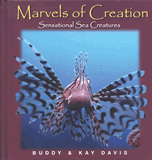Porcupine Fish
There are 15 species of porcupine fish. They live in the warm, tropical seas. The body of the porcupine fish is like an ordinary fish until it is alarmed. Then the porcupine fish inflates its body by taking in water. As its body inflates, its spines, which are flat, stand out. These spines can be two inches (5 cm) long and extremely sharp. The spines are close together and provide a coat of armor for the porcupine fish.
Porcupine fish will also inflate with air if taken from the water. The results are the same. The spines can inflict nasty wounds.
Porcupine fish are slow swimmers. It has rather large eyes for the size of its body. The teeth of the porcupine fish form a plate in the upper jaw with another plate in the lower jaw. Each of these plates has a sharp edge for crushing food. It likes to eat mollusks and pieces of coral. The fleshy part of the coral is digested in the stomach of the porcupine fish, while the stony matter in the coral stays inside the fish. One porcupine fish that was dissected had one pound of coral rock in its stomach!
The porcupine fish have few known enemies. Who would want to swallow a pincushion? However, one incident was observed where a garfish actually swallowed a porcupine fish!
Man does not usually eat porcupine fish because of the poison in its liver and skin. However, it can be eaten if prepared properly. These fish have been used as decorations, war helmets in the South Seas, and lanterns in the Orient.
Porcupine Fish
Tetraodontiformes • Diodontidae
Diodon holacanthus
Length: 1 to 2-1/2 feet (30 cm–76 cm)
Special Design Feature: The porcupine fish
look like ordinary fish until alarmed. Then
they inflate themselves and have sharp
spines all over their bodies.
Did You Know? Dried porcupine fish have
been used for lanterns, war helmets, and
other decorations.

Marvels of Creation: Sensational Sea Creatures
Brings the world of the sea alive in a unique and colorful way with photographs, a page of facts and commentaries.
Browse Kids BookRecommended Resources
- © 2025 Answers in Genesis
- Privacy Policy
- Contact
- About



